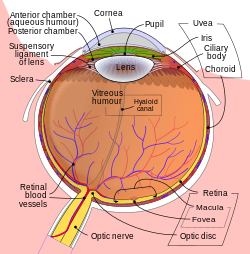
Back نقرة مركزية Arabic ফোভিয়া Bengali/Bangla Fovea centralis BS Fòvea òptica Catalan Fovea centralis German Foveo Esperanto Fóvea Spanish گوده مرکزی Persian Fovéa French Fóvea Galician
| Fovea centralis | |
|---|---|
 Schematic diagram of the human eye, with the fovea at the bottom. It shows a horizontal section through the right eye. | |
| Details | |
| Identifiers | |
| Latin | fovea centralis |
| MeSH | D005584 |
| TA98 | A15.2.04.022 |
| TA2 | 6785 |
| FMA | 58658 |
| Anatomical terminology | |
The fovea centralis is a small, central pit composed of closely packed cones in the eye. It is located in the center of the macula lutea of the retina.[1][2]
The fovea is responsible for sharp central vision (also called foveal vision), which is necessary in humans for activities for which visual detail is of primary importance, such as reading and driving. The fovea is surrounded by the parafovea belt and the perifovea outer region.[2]
The parafovea is the intermediate belt, where the ganglion cell layer is composed of more than five layers of cells, as well as the highest density of cones; the perifovea is the outermost region where the ganglion cell layer contains two to four layers of cells, and is where visual acuity is below the optimum. The perifovea contains an even more diminished density of cones, having 12 per 100 micrometres versus 50 per 100 micrometres in the most central fovea. That, in turn, is surrounded by a larger peripheral area, which delivers highly compressed information of low resolution following the pattern of compression in foveated imaging.[citation needed]
Approximately half the nerve fibers in the optic nerve carry information from the fovea, while the remaining half carry information from the rest of the retina. The parafovea extends to a radius of 1.25 mm from the central fovea, and the perifovea is found at a 2.75 mm radius from the fovea centralis.[3]
The term fovea comes from Latin fovea 'pit'.
The fovea centralis was named by German histologist Carl Bergmann.[4]
- ^ "Simple Anatomy of the Retina". Webvision. University of Utah. Archived from the original on 2011-03-15. Retrieved 2011-09-28.
- ^ a b Iwasaki, M; Inomata, H (1986). "Relation between superficial capillaries and foveal structures in the human retina". Investigative Ophthalmology & Visual Science. 27 (12): 1698–705. PMID 3793399.
- ^ "eye, human".Encyclopædia Britannica. 2008. Encyclopædia Britannica 2006 Ultimate Reference Suite DVD
- ^ Thibos, Larry; Lenner, Katharina; Thibos, Cameron (18 Dec 2023). "Carl Bergmann (1814–1865) and the discovery of the anatomical site in the retina where vision is initiated". Journal of the History of the Neurosciences. 33 (2): 180–203. doi:10.1080/0964704X.2023.2286991. PMID 38109332. S2CID 266361309.